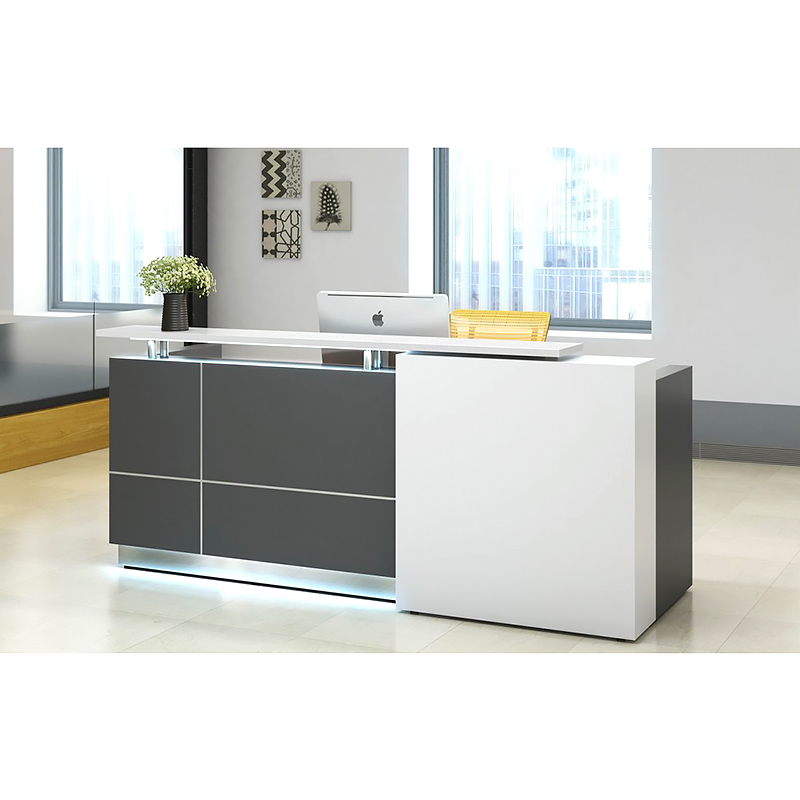Selecting the right reception desk is crucial for making a strong first impression on clients and visitors. This guide will help you navigate the process of choosing a reception desk that meets your business needs. We’ll cover key factors such as desk styles, materials, and budget considerations. By the end, you’ll be equipped to make an informed decision that enhances your office’s functionality and reflects your brand identity. Whether you’re looking for corner desks, executive desks, or standard reception desks, we’ll provide the insights you need to choose wisely.
Understand the Role of a Reception Desk in Business Operations
Understanding the role of a reception desk in business operations is crucial for selecting the right furniture, including office desks, corner desks, and executive desks. This section explores how the desk impacts first impressions, identifies functional needs based on business type, and considers client traffic flow. From glass designs to cabinetry options, the right reception desk enhances the receptionist’s efficiency and contributes to a professional office environment.
Recognise the Impact on First Impressions
The reception desk serves as the focal point of a business’s entrance, setting the tone for client interactions. Its design, from the choice of finish to the placement of office chairs, significantly influences visitors’ perceptions of the company’s professionalism and attention to detail.
A well-designed reception area, complete with a functional desk and comfortable seating, facilitates efficient communication. It provides a space for receptionists to manage emails, organise documents in drawers, and greet clients, contributing to a positive first impression that can impact business relationships.
Identify Functional Needs Based on Business Type
Different business types require specific reception desk features to support their operations. For example, medical offices need desks with accessibility features and secure storage for patient information, while hotels may prioritise a large front desk with multiple workstations to handle guest check-ins efficiently. The functional needs of a business directly influence the design and layout of its reception area.
When identifying functional needs, businesses should consider factors such as the volume of visitor traffic, the types of tasks performed at the reception desk, and the brand image they wish to project. A tech start-up might opt for a sleek, minimalist desk with integrated technology, while a law firm may prefer a more traditional, imposing desk that conveys professionalism and authority. Key considerations include:
- Space for essential equipment (computers, phones, printers)
- Storage solutions for documents and supplies
- Ergonomic design for staff comfort
- Integration of company branding elements
- Accommodation for accessibility requirements
Consider the Flow of Client Traffic
The flow of client traffic significantly impacts the design and placement of reception desks in office spaces across Australia. A well-designed reception area accommodates the movement of visitors, ensuring smooth transitions and minimising congestion. In Los Angeles, where businesses often prioritise sleek, modern aesthetics, reception desks with ample space and strategically placed pedestals can enhance traffic flow while maintaining a stylish appearance.
Efficient client traffic management requires thoughtful consideration of the reception desk‘s location and configuration. JavaScript-powered digital check-in systems integrated into the desk can streamline visitor processing, reducing wait times and improving overall experiences. The reception area’s layout should guide clients naturally from the entrance to the desk and then to designated waiting areas or meeting rooms, creating a seamless flow that reflects the business’s professionalism and attention to detail:
| Traffic Flow Element | Purpose | Example |
|---|---|---|
| Clear Pathways | Guide movement | Wide aisles between furniture |
| Strategic Desk Placement | Facilitate access | Centred or angled for visibility |
| Queue Management | Organise waiting clients | Rope barriers or digital systems |
| Signage | Direct visitors | Digital displays or wall-mounted signs |
Evaluate Different Styles of Reception Desks
Evaluating different styles of reception desks is crucial for businesses, including desk salons. This section examines traditional versus modern designs, assesses ergonomics and accessibility features, and reviews custom and pre-made options. Understanding these aspects helps businesses select a reception desk that aligns with their brand image, functional needs, and budget constraints.
Explore Traditional vs. Modern Designs
Traditional reception desk designs often feature solid wood construction with ornate details, conveying a sense of stability and luxury. These desks typically incorporate rich finishes like mahogany or cherry, with ample storage space and a substantial presence that suits law firms, financial institutions, and high-end hotels.
Modern reception desk designs emphasise clean lines, minimalist aesthetics, and innovative materials such as glass, metal, and engineered wood. These desks often integrate technology seamlessly, with built-in charging stations and sleek cable management systems. Modern designs are popular in tech companies, creative agencies, and contemporary office spaces that prioritise a forward-thinking image.
Assess Ergonomics and Accessibility
Ergonomics plays a crucial role in reception desk design, ensuring staff comfort and productivity during long hours of work. Adjustable height options, proper keyboard trays, and adequate legroom contribute to a healthier work environment. Accessibility features, such as lowered counter sections for wheelchair users, demonstrate inclusivity and compliance with ADA regulations.
When assessing ergonomics and accessibility, businesses should consider the following factors:
| Feature | Benefit | Example |
|---|---|---|
| Adjustable Height | Accommodates different staff heights | Electric sit-stand desks |
| Ergonomic Chair | Reduces back strain | Lumbar support, adjustable armrests |
| Accessible Counter | Serves all clients comfortably | Dual-height reception surface |
| Cable Management | Prevents trip hazards | Built-in wire channels |
Review Custom vs. Pre-Made Options
Custom reception desks offer businesses the opportunity to create a unique, brand-aligned focal point for their entrance. These bespoke solutions allow for precise tailoring of materials, dimensions, and features to match specific operational needs and aesthetic preferences. While custom options typically come with higher price tags and longer lead times, they provide unparalleled flexibility in design and functionality.
Pre-made reception desks present a more cost-effective and readily available alternative. These standardised options come in various styles and configurations, catering to different business types and sizes. Many pre-made desks offer modular components, allowing for some customisation within predetermined parameters. This option suits businesses with tighter budgets or shorter timelines, providing a balance between quality and affordability.
Assess Material and Durability for Long-Term Use
Assessing material and durability is crucial when selecting a reception desk for long-term use. This section compares wood, metal, and laminate options, investigates maintenance requirements, and evaluates environmental impact and sustainability. Understanding these factors helps businesses choose a reception desk that balances aesthetics, functionality, and longevity while aligning with their values and operational needs.
Compare Wood, Metal, and Laminate Options
Wood reception desks offer a timeless appeal and durability, with options ranging from solid hardwoods to engineered wood products. These desks provide warmth and sophistication, making them ideal for traditional or high-end office environments. Solid wood desks, while more expensive, can last for decades with proper care, while engineered wood options offer similar aesthetics at a lower cost.
Metal reception desks provide a sleek, modern appearance and exceptional durability. Stainless steel and aluminium options resist wear and tear, making them suitable for high-traffic areas. Laminate desks offer versatility in design and colour options, with improved durability compared to older versions. These desks resist scratches and stains, making them a practical choice for busy reception areas where aesthetics and easy maintenance are priorities.
Investigate Maintenance Requirements
Maintenance requirements for reception desks vary depending on the material and finish. Wood desks need regular dusting and occasional polishing to maintain their appearance, while metal surfaces often require only wiping with a damp cloth. Laminate desks offer easy maintenance, resisting stains and scratches, but may need periodic edge banding replacement.
Regular maintenance extends the lifespan of reception desks and preserves their appearance. Businesses should establish cleaning routines and train staff on proper care techniques. For high-traffic areas, protective measures such as desk mats or glass tops can prevent wear and tear, reducing long-term maintenance costs and preserving the desk‘s professional appearance.
Evaluate Environmental Impact and Sustainability
Environmental impact and sustainability have become crucial factors in selecting reception desks. Businesses increasingly opt for desks made from sustainably sourced materials, such as FSC-certified wood or recycled metals. These choices reflect a commitment to environmental responsibility and can enhance a company’s green credentials.
Manufacturers now offer reception desks designed for disassembly and recycling at the end of their lifecycle. This approach reduces waste and supports circular economy principles. Additionally, some companies provide take-back programs, ensuring proper disposal or refurbishment of old desks, further minimising environmental impact.
Determine Budget Constraints for Your Reception Desk
Determining budget constraints is essential when selecting a reception desk. This section explores cost-effective solutions that maintain quality and examines financing and leasing options. By understanding these factors, businesses can make informed decisions that balance financial considerations with their reception area needs.
Identify Cost-Effective Solutions Without Sacrificing Quality
Businesses can identify cost-effective reception desk solutions without compromising quality by exploring modular designs. These desks offer flexibility, allowing companies to customise configurations while staying within budget constraints. Modular options often include add-on components, enabling businesses to start with a basic setup and expand as needs grow or finances allow.
Another strategy involves considering refurbished or gently used reception desks from reputable office furniture dealers. These options often provide high-quality materials and craftsmanship at a fraction of the cost of new furniture. When selecting refurbished pieces, businesses should inspect for durability and ensure the desk meets their functional requirements:
| Cost-Effective Solution | Benefits | Considerations |
|---|---|---|
| Modular Designs | Customisable, Scalable | Initial setup costs |
| Refurbished Desks | Quality at lower cost | Limited selection, potential wear |
| Multi-functional Furniture | Space-saving, Versatile | May compromise on specific features |
| Seasonal Sales | New furniture at discounted prices | Timing constraints |
Explore Financing Options and Leasing Opportunities
Businesses can explore financing options for reception desks to manage cash flow effectively. Many office furniture suppliers offer payment plans or partnerships with financial institutions, allowing companies to spread the cost over time. These arrangements often come with competitive interest rates and flexible terms, making high-quality reception desks more accessible to businesses with limited upfront capital.
Leasing opportunities present another viable option for acquiring reception desks without a significant initial investment. This approach allows businesses to update their reception area periodically, ensuring it remains modern and functional. Leasing agreements typically include maintenance services, reducing the overall cost of ownership and providing predictable monthly expenses for budgeting purposes.
Incorporate Brand Identity Into Your Reception Desk Choice
Incorporating brand identity into reception desk selection is crucial for creating a cohesive office environment. This section explores how to align desk design with company values and aesthetics, and utilise colours and logos effectively. By integrating these elements, businesses can reinforce their brand image from the moment visitors enter the reception area.
Align Design With Company Values and Aesthetics
Aligning reception desk design with company values and aesthetics creates a cohesive brand experience for visitors. Companies can achieve this by selecting desk materials, shapes, and finishes that reflect their industry and corporate culture. For example, a tech start-up might choose a sleek, minimalist desk with integrated technology, while a law firm may opt for a traditional wooden desk that conveys stability and professionalism.
The reception desk‘s design can also incorporate subtle brand elements through custom details. Businesses can integrate company colours into desk accents, use brand-specific patterns in glass etchings, or incorporate logo-inspired shapes into the desk‘s structure. These design choices reinforce brand identity and create a memorable first impression for clients and partners.
Utilise Colours and Logos to Enhance Branding
Businesses can effectively utilise colours and logos in reception desk design to enhance branding. By incorporating company colours into the desk‘s materials, finishes, or accent pieces, organisations create a visual connection between their brand and the physical space. This approach extends to the use of company logos, which can be tastefully integrated into the desk‘s front panel or side panels, reinforcing brand recognition from the moment visitors enter the office.
Strategic placement of brand elements on the reception desk helps create a cohesive visual experience. Companies can use digital displays integrated into the desk to showcase dynamic brand content, such as company videos or rotating logo designs. This approach allows for flexibility in branding elements while maintaining a professional appearance, adapting to different events or seasons without altering the desk‘s physical structure.
Plan for Future Needs and Flexibility
Planning for future needs and flexibility is essential when choosing a reception desk. This section examines modular and expandable options that adapt to changing business requirements. It also explores how to select desks that accommodate evolving trends and shifting work environments, ensuring long-term value and functionality for businesses.
Consider Modularity and Expandability
Modular reception desks offer businesses the flexibility to adapt their front office space as needs change. These desks typically consist of interchangeable components that can be rearranged or added to, allowing companies to modify the desk‘s configuration without replacing the entire unit. This adaptability proves particularly valuable for growing businesses or those anticipating changes in their reception area layout.
Expandable reception desks provide a cost-effective solution for businesses planning for future growth. These desks are designed with extension options, such as add-on sections or attachable return units, which can be incorporated as the company’s needs evolve. By investing in an expandable desk, businesses can avoid the expense of purchasing an entirely new reception desk when additional workspace or storage is required.
Adapt to Trends and Changing Business Environments
Reception desks must adapt to evolving business trends and changing work environments. Companies increasingly prioritise flexible spaces that accommodate remote work, hot-desking, and collaborative areas. Reception desks with integrated technology, such as digital check-in systems and video conferencing capabilities, support these modern workplace requirements while maintaining a professional appearance.
The shift towards sustainable and wellness-focused office designs influences reception desk choices. Businesses select desks made from eco-friendly materials and those that promote ergonomic health. This approach aligns with corporate social responsibility initiatives and employee well-being programs. Reception desks that incorporate these features position companies as forward-thinking and employee-centric:
- Height-adjustable surfaces for standing interactions
- Integrated air purification systems
- Biophilic design elements, such as living plant walls
- Energy-efficient LED lighting
- Antimicrobial surface treatments for hygiene
Frequently Asked Questions
How does a reception desk impact overall business operations?
A reception desk serves as the first point of contact for visitors, influencing their initial impression. It streamlines visitor management, enhances security, and facilitates efficient communication within the organisation, ultimately contributing to a more professional and organised business environment.
What are the most popular styles of reception desks available?
Popular reception desk styles include modern, contemporary, traditional, and industrial designs. Materials range from wood and laminate to glass and metal. L-shaped and U-shaped configurations are common, while curved and modular desks offer flexibility. Many feature integrated storage and technology solutions.
Which materials are best for durable, long-lasting reception desks?
Reception desks made from solid wood, metal, or high-quality laminates offer excellent durability. Wood provides a classic look, metal offers modern appeal, and laminates balance aesthetics with cost-effectiveness. These materials resist wear, maintain appearance, and withstand daily use in busy reception areas.
How can I incorporate my brand identity into my reception desk design?
Incorporate your brand identity into your reception desk design by using your company colors, logo, and signature materials. Consider the overall aesthetic of your brand, whether modern, traditional, or eclectic, and reflect this in the desk‘s shape, finishes, and accessories to create a cohesive first impression.
What factors should I consider for future-proofing my reception desk choice?
When future-proofing your reception desk, consider factors like adaptable technology integration, modular design for easy reconfiguration, sustainable materials, ergonomic features, and versatile aesthetics. Prioritise durability and flexibility to accommodate evolving office needs and technological advancements over time.
Selecting the right reception desk is crucial for creating a positive first impression and enhancing operational efficiency. A well-chosen desk aligns with the company’s brand identity, accommodates functional needs, and adapts to future changes in the business environment. By carefully considering factors such as style, materials, ergonomics, and budget constraints, businesses can invest in a reception desk that serves as a centrepiece of their office space. Ultimately, the right reception desk not only welcomes visitors but also reflects the company’s values, professionalism, and commitment to both clients and employees.










